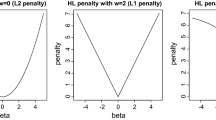Abstract
In this paper the situation of extra population heterogeneity in the standardized mortality ratio is discussed from the point-of-view of an analysis of variance. First, some simple non-iterative ways are provided to estimate the variance of the heterogeneity distribution without estimating the heterogeneity distribution itself. Next, a wider class of linear unbiased estimators is introduced and their properties investigated. Consistency is shown for a wide sub-class of estimators charactererized by the fact that the associated linear weights are within some positive, finite bounds. Furthermore, it is shown that an efficient estimator is often provided when the weights are proportional to the expected counts.
Similar content being viewed by others
References
Aitkin, M., Anderson, D., Francis, B. and Hinde, J. (1990). Statistical Modelling in GLIM, Clarendon Press, Oxford.
Böhning, D. (1994). A note on a test for Poisson overdispersion, Biometrika 81, 418–419.
Böhning, D. (2000). Computer-Assisted Analysis of Mixtures and Applications. Meta-Analysis, Disease Mapping, and Others, Chapman & Hall / CRC, Boca Raton.
Breslow, N. E. (1984). Extra-Poisson variation in log-linear models, Applied Statistics, 33, 38–44.
Clayton, D. and Kaldor, J. (1987). Empirical Bayes estimates of age-standardized relative risks for use in disease mapping, Biometrics, 43, 671–681.
Collet, D. (1991). Modelling Binary Data, Chapman & Hall / CRC, Boca Raton.
Haight, F. A. (1967). The Handbook of the Poisson Distribution, Wiley, New York.
Lawson, A., Biggeri, A., Böhning, D., Lesaffre, E., Viel, J.-F. and Bertollini, R. (1999). Disease Mapping and Risk Assessment for Public Health, Wiley, New York.
Marshall, R. J. (1991). Mapping disease and mortality rates using empirical Bayes estimators, Applied Statistics, 40, 283–294.
Martuzzi, M. and Elliot, P. (1996). Empirical Bayes estimation of small area prevalence of non-rare conditions, Statistics in Medicine, 15, 1867–1873.
Martuzzi, M. and Hills, M. (1995). Estimating the degree of heterogeneity between event rates using likelihood, American Journal of Epidemiology, 141, 369–374.
Pendergast, J. F., Gange, S. J., Newton, M. A., Lindstrom, M. J., Palta, M. and Fisher, M. R. (1996). A survey of methods for analyzing clustered binary response data, International Statistical Review, 64, 89–118.
Pocock, S. J., Cook, D. G. and Beresford, S. A. A. (1981). Regression of area mortality rates on explanatory variables: What weighting is appropriate?, Applied Statistics, 30, 286–295.
Williams, D. A. (1982). Extra-binomial variation in logistic linear models, Applied Statistics, 31, 144–148.
Author information
Authors and Affiliations
About this article
Cite this article
Böhning, D., Malzahn, U., Sarol, J. et al. Efficient Non-Iterative and Nonparametric Estimation of Heterogeneity Variance for the Standardized Mortality Ratio. Annals of the Institute of Statistical Mathematics 54, 827–839 (2002). https://doi.org/10.1023/A:1022419603608
Issue Date:
DOI: https://doi.org/10.1023/A:1022419603608



